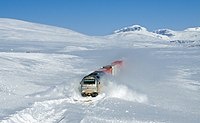
Photo from wikipedia
The Great Lakes region experiences anomalously high seasonal snowfall totals relative to similar latitudes. Although lake‐effect snowstorms are common in this region, snowfall occurs from a variety of storm types.… Click to show full abstract
The Great Lakes region experiences anomalously high seasonal snowfall totals relative to similar latitudes. Although lake‐effect snowstorms are common in this region, snowfall occurs from a variety of storm types. This study examines snowstorms in a subsection of the Lake Ontario basin to develop a classification scheme to categorize the different types of snowstorms affecting the region. From 1985 to 2015, there were 11 different snowstorm types to affect the study area. The classification system was used to assess the frequency of, and snowfall produced by the different storm types within the eastern Great Lakes region. From the classification, snowstorms were categorized as either non‐direct cyclonic storms (NDCS) or direct cyclonic storms (DCS). Lake‐effect snowstorms, a type of NDCS, were the most frequent storm (35.1% of all storms) and accounted for approximately 39.4% of the snowfall. Most lake‐effect storms (37.7%) produced moderate snowfall totals (10.2–25.3 cm), yet heavy snowfall storms (≥25.4 cm) contributed significantly (ρ ≤ .05) more to seasonal snowfall totals than lighter snowfall storms. Direct cyclonic clippers forming over high latitudes of northwestern Canada, were the most frequent DCS in Central New York (11.3% of all storms), with nearly three quarters of the storms originating over Alberta. These storms only contributed 9.2% of the seasonal snowfall in the study area, compared to 12.7% from direct cyclonic Nor'easters forming near the east coast of North America. Although Nor'easters occur less frequently than clippers, when they do occur, they tend to produce heavy widespread snowfall across the region. The classification system proposed can be modified to accommodate snow basins across the globe. Classifying snowstorms will help determine the seasonal snowfall contribution from different storms and aid in future climate predictions, as individual snowstorm types may respond differently to a warming global climate.
Journal Title: International Journal of Climatology
Year Published: 2020
Link to full text (if available)
Share on Social Media: Sign Up to like & get
recommendations!